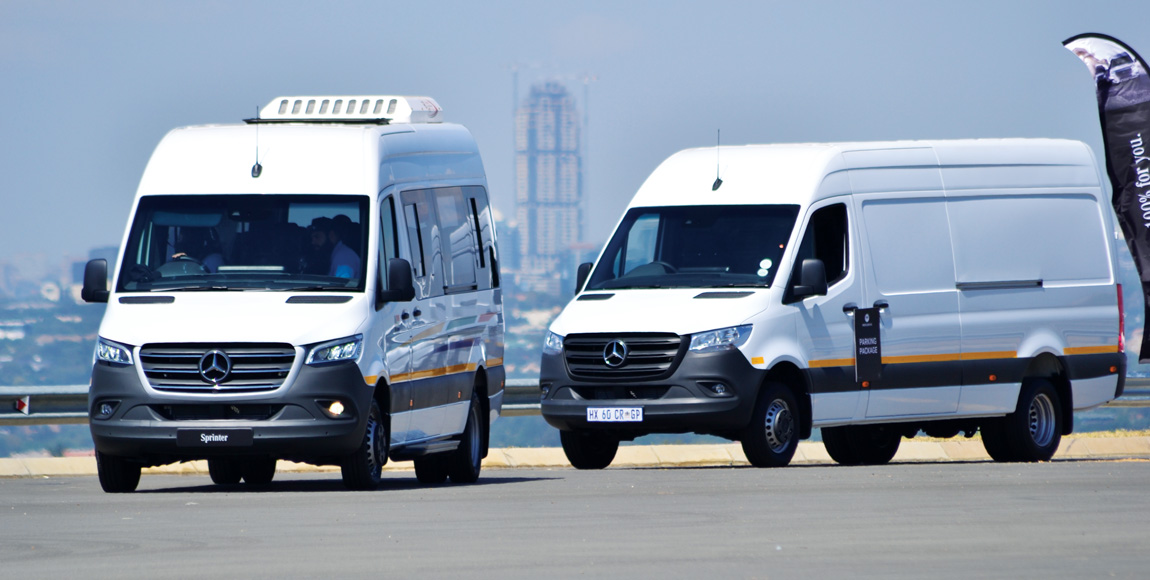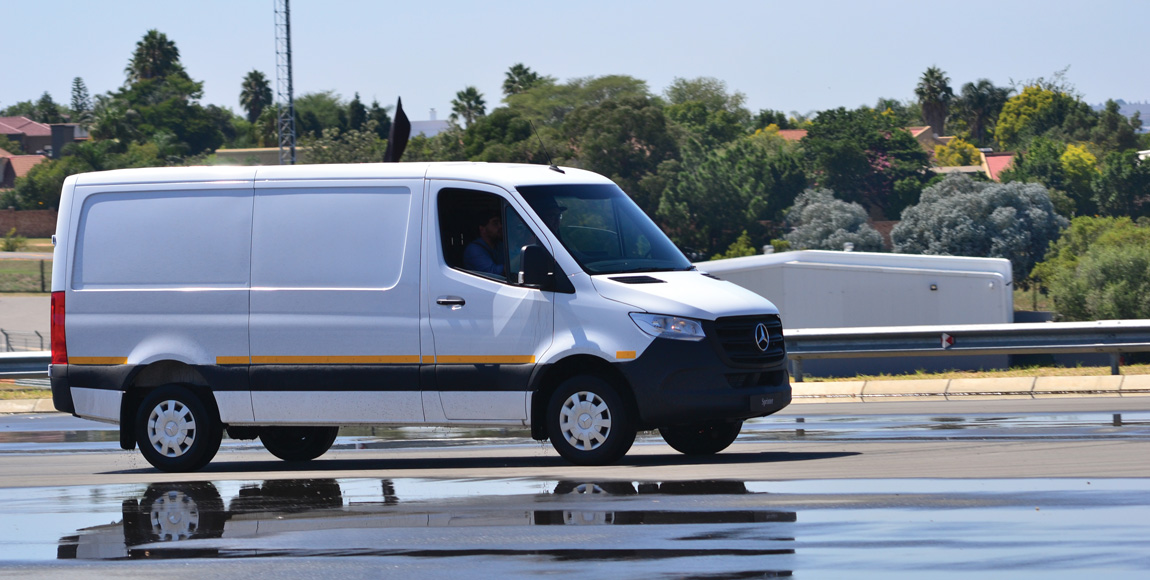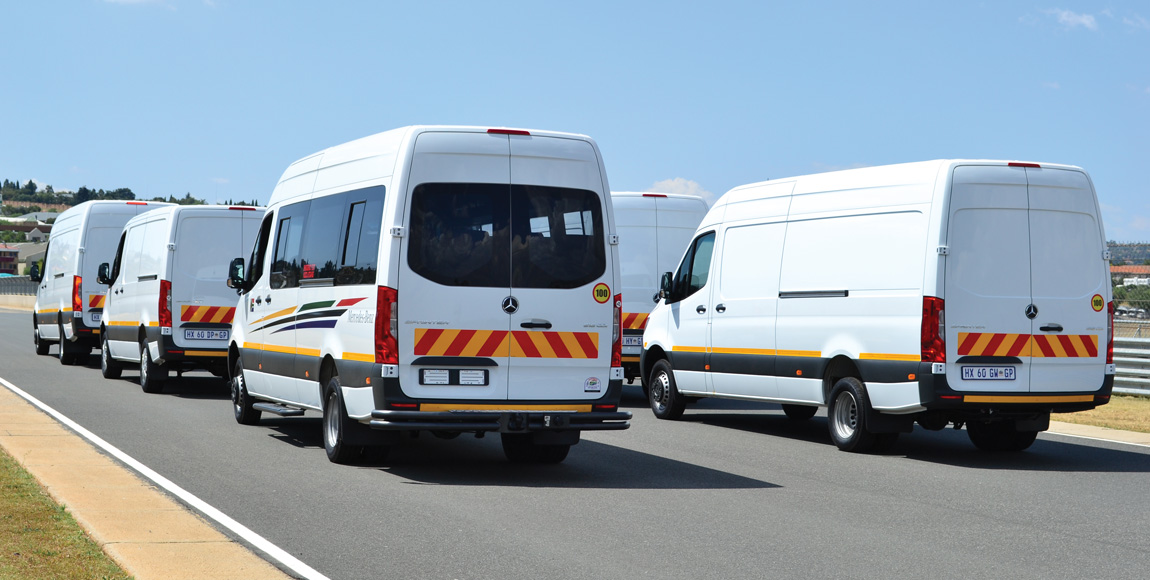Just try to not notice this van…

The third-generation Mercedes-Benz Sprinter has arrived in South Africa and, by all accounts, it looks set to redefine the large-van segment. GAVIN MYERS sampled it at launch
Can you believe that, in 2020, the Mercedes-Benz sprinter will be 25 years old? Since it first debuted, more than 3,4-million Sprinters have been sold worldwide, while the vehicle range has also racked up its fair share of accolades and achieved notable success – even in South Africa where vans, of any size, have to try hard to be noticed.
Nadia Trimmel, vice president of Mercedes-Benz Vans, at Mercedes-Benz South Africa (MBSA), states that, locally, the Sprinter holds the largest market share of the large-van segment in the world.
A key reason for this is its appeal with operators in the long-distance minibus-taxi market, which, she says, has collectively clocked up more than 40-billion kilometres in 20 years of running the Sprinter.
It’s for this reason that the third-generation Sprinter includes a significant, locally developed model in its line-up: the Sprinter Inkanyezi 22-seater.
Designed to meet the needs of this market, the Sprinter Inkanyezi comes in three different grades, with options ranging from the basics like three-point safety belts on every seat, through to passenger USB ports, free-flow rear air-conditioning, rear speakers and many more additions, including an electric sliding side door at the top end.
Operators of the Sprinter Inkanyezi will also benefit from specific support services such as dedicated taxi service bays and flexible servicing hours.

In addition to the Inkanyezi, the Sprinter rage consists of 12 panel-van variants and eight freight-carrier variants, beginning with the new 311 CDI 3,49-t gross vehicle mass (GVM) model. This is another significant addition to the Sprinter range, as it allows drivers with a Code B (Code 8) licence to drive it without worrying about licence or weight restrictions.
The 311 models (3 490 and 3 550 kg) use the 84 kW/300 Nm version of the OM651 2,2-litre four-cylinder turbodiesel engine. Higher up the payload scale, the 316 (3 550 kg) and 516 (5 000 kg) models employ the 120 kW/380 Nm version of this engine.
Mercedes-Benz claims that these high-output engines offer up 10 kW more than the previous unit, while returning an 8,5-percent improvement in fuel consumption and 4,5-percent reduction in terms of cost per kilometre (CPK).
At the top of the Sprinter pecking order are the 519 models (5 000 and 5 500 kg), which boast the three-litre V6 turbodiesel that produces 140 kW and 440 Nm. New six-speed manual and Mercedes-Benz’s 7G-Tronic seven-speed automatic transmissions are available.
As one would expect from large Mercedes-Benz vans, the new Sprinter is really rather nice to drive. The engines are all punchy and smooth and, while the manual transmissions aren’t any chore to use, the 7G-Tronic is sure to find favour, due to its quick response and seamless shifts. The ride is comfortable and refined, even when the vehicle is unladen.
The cabin is very comfortable. Occupants sit on ergonomically designed seats and the minimalist design means the controls and switchgear are easy to operate. There’s a multitude of handy storage spaces.

Visibility, even in the panel van models, is very good, too; giving the driver the confidence to easily manoeuvre the vehicle into and around crowded spaces (which the Sprinter does without sweat). Manoeuvrability is even easier when the Sprinter is equipped with the Parking Package with a 360° camera (one can also have a reversing camera mounted the vehicle’s rear-view mirror).
This system is one of a hoard of safety and convenience equipment that can be had with the new Sprinter. Buyers can optionally spec up to five airbags, LED headlamps, Distronic, Lane Keeping Assist as well as Active Distance Assist Distronic – which automatically regulates the distance from the vehicle ahead. In the event of the vehicle in front decreasing speed, the system will slow the vehicle down to a complete stop.
The standard assistance systems available for the new Sprinter include rain-sensing wipers, Active Brake Assist that warns the driver of oncoming danger, Cross Wind Assist and Hill Start Assist.
The new Sprinter is also one of the few Mercedes-Benz vehicles currently available locally with the advanced MBUX (Mercedes-Benz User Experience) infotainment system (with navigation), which uses artificial intelligence to offer the driver maximum convenience. It’s available with either a seven or 10,25-inch HD display, controlled either with touch-enabled steering wheel controls, or an all-new voice control system.

Drivers will also appreciate the keyless start, air-conditioning, wireless charging facilities and Type-C USB ports. Overall, Mercedes-Benz proudly proclaims that the Sprinter offers a best-in-class range of features.
However, vans are not bought for their gizmos and gadgets – they need to work. In this regard, Mercedes-Benz has endeavoured to meet as wide a variety of needs as possible. Two roof heights and three body-length options are offered. Maximum cargo volume is up to 15,5 m3, with a payloads of up to 3 144 kg. Trailer loads of up to two tonnes can be hitched.
A staggering 600 items of special equipment can be spec’d to a Sprinter, and MBSA has identified six ISO 9001-certified van partners that can do approved conversions to the new model. Anything from ambulances and car transporters, to custom luxury lounges on wheels or go-anywhere family camper-vans – and more – can be had.
The new Sprinter range starts from R461 783 and includes a five-year/100 000 km service plan (service intervals are
20 000 km) which is updatable to maintenance plans.
While large vans in South Africa continue to play second-fiddle to smaller van-bodied trucks, operators will have to try hard to not notice the new Sprinter … which will surely continue its reign in the segment.
Published by
Focus on Transport
focusmagsa




